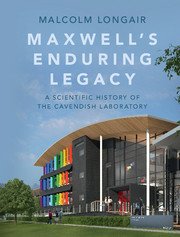Book contents
- Frontmatter
- Dedication
- Contents
- Preface
- Acknowledgements
- Part I To 1874
- Part II 1874 to 1879
- Part III 1879 to 1884
- Part IV 1884 to 1919
- Part V 1919 to 1937
- Part VI 1938 to 1953
- Part VII 1953 to 1971
- Part VIII 1971 to 1982
- Part IX 1984 to 1995
- 19 The Edwards era: a new epoch of expansion
- 20 The Edwards era: new directions in condensed matter physics
- 21 The Edwards era: high–energy physics and radio astronomy
- Part X 1995 to present
- Appendix The evolution of the New Museums site
- Notes
- References
- Author index
- Subject index
20 - The Edwards era: new directions in condensed matter physics
from Part IX - 1984 to 1995
Published online by Cambridge University Press: 05 July 2016
- Frontmatter
- Dedication
- Contents
- Preface
- Acknowledgements
- Part I To 1874
- Part II 1874 to 1879
- Part III 1879 to 1884
- Part IV 1884 to 1919
- Part V 1919 to 1937
- Part VI 1938 to 1953
- Part VII 1953 to 1971
- Part VIII 1971 to 1982
- Part IX 1984 to 1995
- 19 The Edwards era: a new epoch of expansion
- 20 The Edwards era: new directions in condensed matter physics
- 21 The Edwards era: high–energy physics and radio astronomy
- Part X 1995 to present
- Appendix The evolution of the New Museums site
- Notes
- References
- Author index
- Subject index
Summary
Pepper and semiconductor physics
Michael Pepper's association with the Laboratory dated back to 1973 when his collaboration with Mott began and he established a joint research programme with John Adkins to study the low-temperature behaviour of two-dimensional electron gases. His research programme was supported for the period 1978 to 1986 by a Warren Research Fellowship of the Royal Society, the 1978 advertisement stating that the fellowship was
for research in metallurgy, engineering, physics or chemistry, or for the use or application of such research or its results in or for industry and industrial development.
Pepper's involvement in the discovery of the quantum Hall effect during the tenure of the fellowship was an outstanding example of the pursuit of the aims of basic research and industrial application (Section 18.2). In 1982, he transferred his research activity as Principal Research Fellow to the GEC Hirst Research Centre.
The formation of the Semiconductor Physics Group took place formally in 1984 under Pepper's leadership. This marked the beginning of a major expansion of the activity and facilities for semiconductor physics, Pepper using his industrial contacts to support the rapid development of the group, which was to become one of the largest in the Laboratory. Following his pioneering work on Anderson localisation, variable-range hopping and related topics, inspired by his association with Nevill Mott, he led the construction of a series of facilities for the production of semiconductor devices using the techniques of molecular beam epitaxy (MBE) and electron beam lithography (EBL). MBE is an ultra-high-vacuum technique for the deposition of thin films of various semiconductors and insulators layerby- layer from an evaporated beam of particles, what is known as epitaxial growth. This technique is used to grow very high-purity III-V semiconductors in which the thickness of layers can be controlled with sub-monolayer precision (Box 20.1(a)). The resulting layered materials are referred to as heterostructures or heterojunctions. The substrates on which the patterns are laid down are created by EBL, an example of the current Leica Nanowriter facility being shown in Box 20.1(b). As well as being used for many projects within the Laboratory, samples were provided for many other universities and for industrial organisations.
- Type
- Chapter
- Information
- Maxwell's Enduring LegacyA Scientific History of the Cavendish Laboratory, pp. 467 - 505Publisher: Cambridge University PressPrint publication year: 2016



